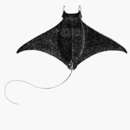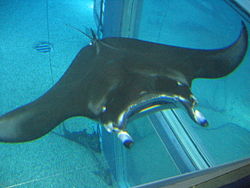ar
الأسماء في صفحات التنقل


The spinetail devil ray (Mobula japanica), also known as the spinetail mobula ray or Japanese mobula ray, is a species of pelagic marine fish which belongs to the family Mobulidae. It is found throughout the tropical and sub-tropical waters of the Indo-Pacific and eastern Atlantic Ocean.
Some analyses suggest that the species should be considered conspecific with the devil fish (Mobula mobular).[3][4] It is no longer recognised as a species by the IUCN.
The spinetail mobula ray is a large ray which can grow up to a maximal width of 3.1 m (10 ft); average width is 2.3 m (7 ft 7 in).[5][6] Like most rays, it is dorsoventrally flattened and has relatively large triangular pectoral fins on either side of the main body disc. At the front, it has a pair of cephalic fins which are forward extensions of the pectoral fins. These can be rolled up in a spiral for swimming or can be flared out to channel water into the ventral mouth when the animal is feeding.
The background body coloration of the dorsal side is deep blue-mauve with a large black band stretches from eye to eye. The ventral side is white. The inner surface of the cephalic fins are silver-grey with black tips, while the outer surface and side behind eye are white.
The species can be distinguished from other large rays by its projecting head, a white-tipped dorsal fin, a spine between the base of the dorsal fin and the start of the tail, and the length of its tail. Its spiracle is just above the area where the pectoral fin meets the body.[7]
Little information exists about the distribution of this species. It is assumed to have a circumglobal distribution in tropical and temperate waters, both inshore and offshore and fully oceanic. The southern Gulf of California appears to be an important mating and pupping ground.[1]
The spinetail mobula ray has a pelagic lifestyle and has been observed both alone and in groups. It feeds on zooplankton by filtering sea water.
As all Mobulidae, species is ovoviviparous. After mating, the fertilized eggs develop within the female's oviduct. At first, they are enclosed in an egg case while the developing embryos feed on the yolk. After the egg hatches, the pup remains in the oviduct and receives nourishment from a milky secretion.[8] The pup is 70–85 cm in disc width at birth.[5]
In recent years, fishing for Mobulidae has received a significant boost by price increases for their gill rakers in the market for traditional Chinese medicine. In addition to targeted catches, the species is also subject to losses from bycatch, particularly in the gillnet fishery. As such sustained losses have a high impact on a species which has a low fecundity rate, a long gestation period with only a single offspring at a time, and late sexual maturity, the spinetail mobula ray has been classified as Near Threatened by the IUCN.[1]
The spinetail devil ray (Mobula japanica), also known as the spinetail mobula ray or Japanese mobula ray, is a species of pelagic marine fish which belongs to the family Mobulidae. It is found throughout the tropical and sub-tropical waters of the Indo-Pacific and eastern Atlantic Ocean.
La manta de espina, manta de aguijón o manta arpón (Mobula japanica) es una especie de pez miliobatiforme de la familia Myliobatidae.[2] Se encuentra en los océanos Atlántico, Índico y Pacífico, siendo su distribución posiblemente circumpolar.[1]
La manta de espina, manta de aguijón o manta arpón (Mobula japanica) es una especie de pez miliobatiforme de la familia Myliobatidae. Se encuentra en los océanos Atlántico, Índico y Pacífico, siendo su distribución posiblemente circumpolar.
Mobula japanica Mobula generoko animalia da. Arrainen barruko Myliobatidae familian sailkatzen da.
Mobula japanica Mobula generoko animalia da. Arrainen barruko Myliobatidae familian sailkatzen da.
Raie mobula aiguillat, Raie mobula japonaise
Mobula japanica, communément appelé Raie mobula aiguillat ou Raie mobula japonaise, est une espèce de poissons marins pélagiques de la famille des Mobulidae. Mobula japanica est depuis peu considérée comme conspécifique à Mobula mobular, c’est-à-dire qu'il s'agirait de la même espèce[4]. Elle n'est de ce fait plus reconnue par l'IUCN en tant que Mobula japanica[5].
Mobula japanica a été observée à des profondeurs allant de 0 à 649 m et sa taille estimée est de 314 cm de largeur de disque[6]. Cette espèce a été décrite pour la première fois en 1841 par Müller et Henle et aurait une répartition globale tropicale et subtropicale.
Mobula japanica est un poisson de grande taille qui peut atteindre une envergure maximale de 3,10 m. Cependant, la taille moyenne généralement observée est de l'ordre de 2,30 m[7],[8].
Elle est identifiable par sa tête qui se détache du corps, de légers reflets argentés sur ses nageoires céphaliques, la position ventrale de sa bouche ainsi que la présence d'un petit aiguillon sur la base postérieure de la nageoire dorsale et d'une tache blanche à son sommet. Le spiracle se situe juste au-dessus de la jonction de la nageoire pectorale et du corps. La teinte de la face dorsale est bleu-mauve sombre et une large bande noire traverse la tête joignant un œil à l'autre. La partie ventrale est blanche.
Mobula japanica fréquente les eaux tropicales et tempérées de l'océan Indo-Pacifique jusqu'à la partie orientale de l'océan Pacifique ainsi que la zone centre-est de l'océan Atlantique[9].
Peu d'études et d'informations relatives à ces raies existent, il est donc supposé qu'elles vivent plutôt dans les eaux proches des côtes[10].
Mobula japanica a un mode de vie pélagique. Elle peut être aussi bien observée en groupe ou solitaire. Elle se nourrit en filtrant l'eau de mer afin de capturer son alimentation favorite, le zooplancton.
Cette raie, comme les autres membres de la famille des Mobulidae, est vivipare aplacentaire. Après accouplement, la femelle libère un œuf qui éclora dans son utérus. Le petit demeurera lové dans l'utérus de sa mère jusqu'à ce qu'il soit totalement développé. Durant cette période de gestation, le petit se nourrit d'abord à partir de ses réserves vitellines puis via des structures spécialisées d'une sorte de lait utérin délivré par l'organisme de sa mère, nommé hisotrophe[11].
À la naissance, le petit mesure entre 70 et 85 cm[7].
Ces dernières années, la pêche de Mobulidae est stimulée par la flambée du cours de leurs plaques branchiales sur le marché de la médecine traditionnelle chinoise. De pseudo-vertus médicinales leur sont conférées, sans aucun fondement scientifique avéré, ainsi qu’une stratégie marketing génèrent une importante demande. Quel que soit le type de pêche (artisanale, ciblée ou prise malencontreuse), l’impact de cette dernière sur une population qui possède un taux de fécondité faible, une maturité sexuelle tardive ainsi qu’une gestation longue ne peut être que gravement nuisible pour ces espèces qui ne peuvent compenser les pertes que sur plusieurs décennies. Des chiffres mondiaux de 2011 ont enregistré un prélèvement de plus de 94 000 animaux, dont plus de 50% proviennent du Sri Lanka, où l'espèce la plus fréquemment pêchée est Mobula japanica (87%), suivie par Mobula tarapacana (12%) et Mobula thurstoni (1%).
Raie mobula aiguillat, Raie mobula japonaise
Mobula japanica, communément appelé Raie mobula aiguillat ou Raie mobula japonaise, est une espèce de poissons marins pélagiques de la famille des Mobulidae. Mobula japanica est depuis peu considérée comme conspécifique à Mobula mobular, c’est-à-dire qu'il s'agirait de la même espèce. Elle n'est de ce fait plus reconnue par l'IUCN en tant que Mobula japanica.
Mobula japanica a été observée à des profondeurs allant de 0 à 649 m et sa taille estimée est de 314 cm de largeur de disque. Cette espèce a été décrite pour la première fois en 1841 par Müller et Henle et aurait une répartition globale tropicale et subtropicale.
Mobula japanica is een vissensoort uit de familie van de adelaarsroggen (Myliobatidae).[1] De wetenschappelijke naam van de soort is voor het eerst geldig gepubliceerd in 1841 door Müller & Henle.
Bronnen, noten en/of referentiesMobula japanica é uma espécie de peixe da família Mobulidae.
Pode ser encontrada nos seguintes países: Austrália, Bangladesh, Brasil, Camboja, China, Colômbia, Costa Rica, Costa do Marfim, Equador, El Salvador, Fiji, Guatemala, Honduras, Índia, Indonésia, Japão, Coreia do Norte, Coreia do Sul, México, Myanmar, Nova Zelândia, Nicarágua, Omã, Paquistão, Panamá, Peru, Filipinas, Somália, África do Sul, Sri Lanka, Taiwan, Tailândia, Tuvalu, Estados Unidos da América, Vietname e Iémen.
Os seus habitats naturais são: mar aberto, mar costeiro e recifes de coral.
Mobula japanica é uma espécie de peixe da família Mobulidae.
Pode ser encontrada nos seguintes países: Austrália, Bangladesh, Brasil, Camboja, China, Colômbia, Costa Rica, Costa do Marfim, Equador, El Salvador, Fiji, Guatemala, Honduras, Índia, Indonésia, Japão, Coreia do Norte, Coreia do Sul, México, Myanmar, Nova Zelândia, Nicarágua, Omã, Paquistão, Panamá, Peru, Filipinas, Somália, África do Sul, Sri Lanka, Taiwan, Tailândia, Tuvalu, Estados Unidos da América, Vietname e Iémen.
Os seus habitats naturais são: mar aberto, mar costeiro e recifes de coral.
Cá ó dơi Nhật Bản[1], tên khoa học Mobula japanica, là một loài cá thuộc họ Mobulidae. Chúng được tìm thấy ở Úc, Bangladesh, Brasil, Campuchia, Trung Quốc, Colombia, Costa Rica, Bờ Biển Ngà, Ecuador, El Salvador, Fiji, Guatemala, Honduras, Ấn Độ, Indonesia, Nhật Bản, Triều Tiên, Hàn Quốc, México, Myanma, New Zealand, Nicaragua, Oman, Pakistan, Panama, Peru, Philippines, Somalia, Nam Phi, Sri Lanka, Đài Loan, Thái Lan, Tuvalu, Hoa Kỳ, Việt Nam, và Yemen. Các môi trường sống tự nhiên của chúng là vùng biển mở, shallow seas, và các vùng đô thị.
Cá ó dơi Nhật Bản, tên khoa học Mobula japanica, là một loài cá thuộc họ Mobulidae. Chúng được tìm thấy ở Úc, Bangladesh, Brasil, Campuchia, Trung Quốc, Colombia, Costa Rica, Bờ Biển Ngà, Ecuador, El Salvador, Fiji, Guatemala, Honduras, Ấn Độ, Indonesia, Nhật Bản, Triều Tiên, Hàn Quốc, México, Myanma, New Zealand, Nicaragua, Oman, Pakistan, Panama, Peru, Philippines, Somalia, Nam Phi, Sri Lanka, Đài Loan, Thái Lan, Tuvalu, Hoa Kỳ, Việt Nam, và Yemen. Các môi trường sống tự nhiên của chúng là vùng biển mở, shallow seas, và các vùng đô thị.
Японские мобулы встречаются у берега и в открытом море, держатся как поодиночке, так и стаями[10]. Подобно прочим хвостоколообразным они относятся к яйцеживородящим рыбам. Эмбрионы развиваются в утробе матери, питаясь желтком и гистотрофомruen. В помёте как правило один новорождённый с диском шириной 70—85 см. В водах Индонезии самцы достигают половой зрелости при ширине диска 205—210 см, а в Калифорнийском заливе самцы и самки становятся половозрелыми при ширине диска 210 см и 207 см соответственно[5]. Рацион этих скатов в основном состоит из эвфаузиевых (преимущественно Nictiphanes simplex), веслоногих рачков и личинок ракообразных. Кроме того, они могут охотиться на мелких стайных рыб. Акустические данные свидетельствуют о том, что ночью японские мобулы проводят время над термоклином, кормясь крилем[4].
На японских мобулах паразитируют цестоды Fellicocestus mobula, Hemionchos maior, Hemionchos mobulae, Hemionchos striatus[11], Healyum harenamica, Healyum pulvis и Quadcuspibothrium francis[12], веслоногие Entepherus laminipes[13], Eudactylina oliveri[14] и Kroyerina mobulae[15] и равноногие Gnathia grandilaris и Gnathia trimaculata[16].
Японские мобулы являются объектом коммерческого промысла. Высоко ценятся жаберные тычинки мобул, кроме того используют мясо, хрящи и шкуру[17]. Часто попадаются в качестве прилова в ходе лова полосатых тунцов[4]. Международный союз охраны природы присвоил виду охранный статус «Близкий к уязвимому положению»[5].
日本蝠魟(学名:Mobula japanica),又名日本蝠鱝、飛魴仔、鷹魴,为燕魟科蝠鱝屬下的一个种。分布于日本、朝鲜、夏威夷群岛以及南海、东海等海域。该物种的模式产地在日本。[2]
|access-date=中的日期值 (帮助) 
イトマキエイ(糸巻鱏、糸巻鱝、学名Mobula japonica)は、トビエイ目トビエイ科に属するエイの一種。
全長約3m程で、近似種のオニイトマキエイに比べて、体が幾分小柄で、また、口の脇にある鰭も小さく、全般的にオニイトマキエイよりも体も尾も細く、尾はかなり長い。
尾の付け根部分にエイ特有の毒針があるが、アカエイ類やトビエイ類ほど大きくなく、毒性もそれほどではない。
暖海性のエイで、日本では、千葉県以南の太平洋一帯に生息する。
外洋の表層を単独あるいは群れで遊泳する。主なえさはプランクトンで、口を開けて海水ごと吸い込み、口の中の鰓でこしとって食べる。
磯や、珊瑚礁の側にも寄ってきて、小魚たちに体表に付いた寄生虫やゴミなどを食べてもらったりもする。
肉は不味いので、あまり食用にはされず、主に肥料や、家畜の飼料などに使われるため、乾燥させて使われる。
有名な“マンタ”ことオニイトマキエイと、本種より小さいヒメイトマキエイがおり、いずれも食性も生態も、本種に似ている。